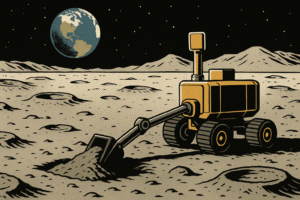Exclusive: Mining the Moon for Helium-3 — The Next Energy Revolution
Focus Keyword: Mining the Moon

In a bold move that echoes science fiction, American companies are gearing up to mine the Moon for Helium-3 (He-3), a rare isotope with extraordinary potential as a clean energy source. Unlike fossil fuels, Helium-3 could revolutionize nuclear fusion and provide Earth with virtually limitless power. This mission isn’t just about exploration—it’s about survival, sustainability, and scientific advancement.
What is Helium-3 and Why is it Valuable?
Helium-3 is a non-radioactive isotope of helium. Unlike the commonly used helium-4, it has two protons and one neutron. The isotope is rare on Earth but abundant on the Moon, especially in the lunar regolith, which has absorbed solar wind for billions of years. Helium-3 is prized because it could be the key to clean nuclear fusion—energy without greenhouse gases or radioactive waste.
Why the Moon?
Earth’s supply of Helium-3 is negligible, but the Moon has been soaking up solar wind particles, including He-3, for billions of years. Estimates suggest there may be over one million metric tons of Helium-3 on the Moon—enough to power Earth for thousands of years if harnessed correctly. The lunar surface offers a natural vault for this futuristic fuel.
The Role of U.S. Companies in Space Mining
Several American firms are leading the charge. One in particular has developed robotic rovers capable of extracting Helium-3 from lunar soil. These robots will not only mine the resource but will also be used to launch payloads back to Earth, reducing dependency on traditional spacecraft. The U.S. government, through NASA’s Artemis program and partnerships with private space companies, has endorsed the Moon as a commercial frontier.
How Helium-3 Fusion Works
Unlike the nuclear fusion we often hear about, which typically involves deuterium and tritium (resulting in radioactive waste), fusion using Helium-3 and deuterium produces no dangerous neutrons. The result is clean, efficient, and virtually waste-free energy. While this technology is still in development, research labs around the world—including those in the U.S., China, and Europe—are working to build the reactors that will make this dream a reality.
Challenges of Mining the Moon
Mining the Moon is not without its challenges. Harsh environmental conditions, long communication delays, and the logistics of launching and landing heavy payloads are significant hurdles. However, recent advances in autonomous robotics, 3D printing, and low-cost space launches (thanks to companies like SpaceX) are rapidly closing those gaps.
Global Competition and Legal Questions
The race for Helium-3 is not limited to the United States. China, Russia, and the European Space Agency are also eyeing the Moon. The 1967 Outer Space Treaty, which prohibits national appropriation of celestial bodies, adds legal complexity. However, the 2020 Artemis Accords seek to create a framework for peaceful and cooperative exploration of the Moon.
Environmental and Ethical Implications
Critics warn of the environmental impact of exploiting the Moon, a celestial body untouched by human industry. Ethical questions also arise: Who owns the Moon’s resources? How do we ensure equitable access? These concerns are shaping the international conversation on space policy and sustainability.
Conclusion: A Giant Leap Toward Sustainable Energy
The idea of mining the Moon for Helium-3 is no longer science fiction—it is a scientific and economic frontier being actively pursued. With growing support from governments and the private sector, the dream of clean, abundant energy may lie not on Earth, but 384,000 kilometers away on the lunar surface. As we look up at the Moon, we may soon see not just a symbol of mystery and romance—but the fuel for our future.
Author: GlobalLense Team | Category: Energy, Space Exploration
External Sources:
ISRO’s PSLV-C61 Mission Failure: What Happened and What Comes Next?


